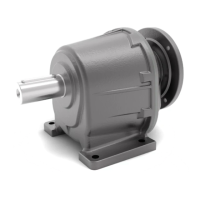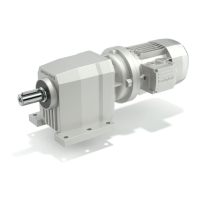13
n
1
il riduttore che, in funzio
-
ne del rapporto [i] più pros
-
simo a quello calcolato, pro
-
ponga una coppia nominale:
Se al riduttore scelto dovrà
essere applicato un motore
elettrico verificarne l’applica-
bilità consultando la tabella
delle predisposizioni possi-
bili paragrafo 24.
input speed n
1
and locate the
gear unit that features the
gear ratio closest to [i] and at
same time offers a rated
torque value M
n2
so that:
If a IEC normalized motor
must be fitted check geo
-
metrical compatibility with
the gear unit at paragraph
24 - Motor availability.
auswählen, das in Abhängig
-
keit von einer Übersetzung
[i], die dem Sollwert mög
-
lichst nahe ist, folgendes
Nenn-Drehmoment erlaubt:
Wenn das Getriebe mit ei
-
nem Elektromotor verbun
-
den werden soll, die Ver-
träglichkeit anhand der Ta-
belle der möglichen Anbau-
möglichkeiten sicherstellen.
dant à la vitesse n
1
le réduc
-
teur qui, en fonction du
rapport [i] le plus proche de
celui calculé, propose un
couple nominal :
Au cas où il serait nécessaire
d’appliquer un moteur élec
-
trique normalisé au réducteur
choisi, en vérifier la possible
adaptation en consultant le
tableau des prédispositions
possibles présenté.
M
n2
³ M
c2
(15)
11 - VERIFICHE
Effettuata la corretta selezione
delle motorizzazioni, si consi-
glia di procedere alle seguenti
verifiche:
a) Potenza termica
Assicurarsi che la potenza
termica del riduttore, abbia
un valore uguale o maggio-
re alla potenza richiesta
dall’applicazione secondo la
relazione (3) a pag. 6, in
caso contrario selezionare
un riduttore di grandezza
superiore oppure provvede-
re ad applicare un sistema
di raffreddamento forzato.
b) Coppia massima
Generalmente la coppia
massima (intesa come punta
di carico istantaneo) applica-
bile al riduttore non deve su-
perare il 200% della coppia
nominale M
n2
; verificare per-
tanto che tale limite non
venga superato adottando,
se necessario, opportuni di-
spositivi per la limitazione
della coppia.
Per i motori trifase a doppia
polarità è necessario rivol-
gere particolare attenzione
alla coppia di commutazione
istantanea che viene gene-
rata durante la commutazio-
ne dall’alta velocità alla bas-
sa in quanto può essere de
-
cisamente più elevata della
coppia massima stessa.
Un metodo semplice ed eco
-
nomico per ridurre tale cop
-
pia è quello di alimentare
solo due fasi del motore du
-
rante la commutazione (il
tempo di alimentazione a
due fasi può essere regolato
mediante un relè a tempo):
11 - VERIFICATION
After selection is complete it
may be worth checking on the
following:
a) Thermal capacity
Make sure that the thermal
capacity of the gearbox is
equal to or greater than the
power required by the appli-
cation according to equation
(3) on page 6. If this condi-
tion is not verified, select a
larger gearbox or apply a
forced cooling system.
b) Maximum torque
The maximum torque (in-
tended as momentary peak
load) applicable to the gear-
box must not, in general, ex-
ceed 200% of rated torque
M
n2
. Therefore, check that
this limit is not exceeded,
using suitable torque limiting
devices, if necessary.
For three-phase double
speed motors, it is important
to pay attention to the
switching torque which is
generated when switching
from high to low speed, be-
cause it could be signifi-
cantly higher than maximum
torque.
A simple, economical way to
minimize overloading is to
power only two phases of
the motor during switch-over
(power-up time on two
phases can be controlled
with a time-relay):
11 - PRÜFUNGEN
Nach Wahl des Getriebemotors
folgende Prüfungen ausführen:
a) Thernische Grenzleistung
Sicherstellen, daß die Wär-
meleistung des Getriebes
größer oder gleich der ver-
langten Leistung ist, die von
der Anwendung nach Glei-
chung (3) auf S. 6 verlangt
wird. Andernfalls ein größer
dimensioniertes Getriebe
wählen bzw. ein Zwangs-
kühlsystem vorsehen.
b) Max. Drehmoment
Im allgemeinen darf das max.
Drehmoment (verstanden als
mom entane Lastspitze), das
auf das Getriebe aufgebracht
werden kann, 200 % des
Nenndrehmoments M
n2
nicht
überschreiten. Sicherstellen,
daß dieser Grenzwert nicht
überschritten wird, und nöti-
genfalls die entsprechenden
Vorrichtungen zur Begren-
zung des Drehmoments vor-
sehen. Bei polumschaltbaren
Drehstrommotoren muss dem
Umschaltdrehmoment, das
beim Umschalten von der ho-
hen auf die niedrige Drehzahl
erzeugt wird, besondere Auf-
merksamkeit geschenkt wer
-
den, da es entschieden grö
-
ßer sein kann als das
Nenn-Drehmoment. Eine ein
-
fache und kostengünstige Me
-
thode zum Senken dieses
Drehmoments besteht darin,
daß nur zwei Phasen des Mo
-
tors während des Umschal
-
tens gespeist werden (die
Dauer der Speisung von nur 2
Phasen kann durch ein Zeitre
-
lais gesteuert werden):
11 - VERIFICATIONS
Après avoir effectué une sélec-
tion correcte des motorisations,
nous conseillons de proceder
aux vérifications suivantes :
a) Puissance thermique
S’assurer que la puissance
thermique du réducteur ait
une valeur supérieure ou
égale à la puissance re-
quise par l’application selon
l’équation (3) page 6. Dans
le cas contraire, sélection-
ner un réducteur de taille
supérieure ou bien prevoir
un système de refroidisse-
ment forcé.
b) Couple maximum
Généralement, le couple
maximum (à considerer com-
me une pointe de charge ins-
tantanée) applicable au ré-
ducteur ne doit pas dépasser
les 200% du couple nominal
M
n2
. Verifier par conséquent
que cette limite ne soit pas
dépassée en adoptant, si né-
cessaire, des dispositifs adap-
tés pour limiter le couple.
Pour les moteurs triphasés à
double polarité, il est néces-
saire de prêter une attention
particulière au couple de com-
mutation instantané qui est
généré lors du passage de la
grande à la petite vitesse
étant donné qu’il peut être
considérablement plus élevé
que le couple maximum lui
même.
Une méthode simple et éco
-
nomique pour réduire ce
couple consiste à alimenter
seulement deux phases du
moteur pendant la commuta
-
tion (la durée d’alimentation
sur deux phases peut être
réglée au moyen d’un relais
temporisateur) :

